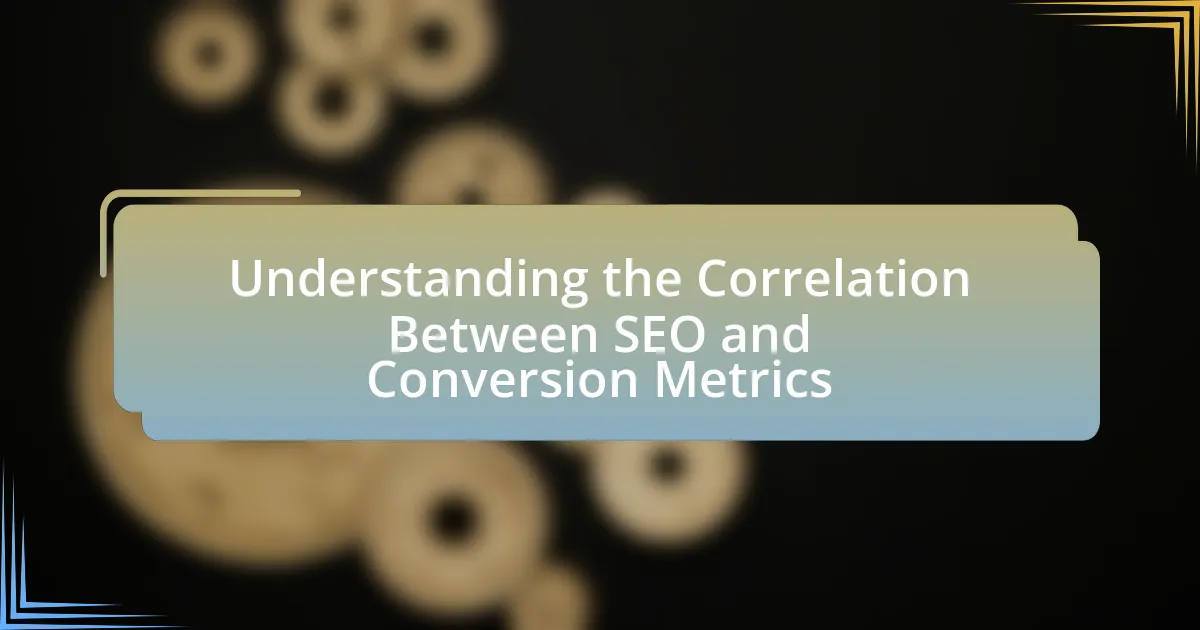Bounce rate is a critical metric that measures the percentage of visitors who leave a website after viewing only one page, serving as an indicator of user engagement and website performance. A high bounce rate often signifies that users find the content irrelevant or unengaging, which can adversely affect conversion rates. The article explores the definition of bounce rate, its significance in digital analytics, and the factors influencing its levels, such as content relevance and page load speed. It also discusses how bounce rate varies across different platforms, the importance of monitoring it for businesses, and strategies to effectively utilize this metric to enhance user engagement and overall website performance. Additionally, best practices for analyzing bounce rate and common pitfalls to avoid are highlighted, providing a comprehensive understanding of how to leverage bounce rate for improved user retention and engagement.

What is Bounce Rate and Why is it Important for User Engagement?
Bounce rate is the percentage of visitors who navigate away from a website after viewing only one page. It is important for user engagement because a high bounce rate often indicates that users are not finding the content relevant or engaging enough to explore further, which can negatively impact conversion rates and overall site performance. Research shows that websites with lower bounce rates tend to have higher user engagement metrics, such as time spent on site and pages per session, suggesting that effective content and user experience can significantly enhance user retention and interaction.
How is Bounce Rate Defined in Digital Analytics?
Bounce rate in digital analytics is defined as the percentage of visitors who navigate away from a website after viewing only one page. This metric indicates user engagement by measuring how effectively a website retains visitors; a high bounce rate suggests that users are not finding the content relevant or engaging enough to explore further. According to Google Analytics, a bounce is recorded when a user enters a site and exits without triggering any other requests to the analytics server during that session.
What factors contribute to a high or low Bounce Rate?
A high or low Bounce Rate is primarily influenced by factors such as content relevance, page load speed, user experience, and audience targeting. Content relevance ensures that visitors find what they expect, which can lower the Bounce Rate; for instance, a study by HubSpot found that 55% of visitors spend fewer than 15 seconds on a website if the content does not meet their needs. Page load speed is critical, as Google reports that a delay of just one second can reduce conversions by 7%. User experience, including mobile optimization and intuitive navigation, also plays a significant role; according to a report by Adobe, 38% of users will stop engaging with a website if the content or layout is unattractive. Lastly, effective audience targeting ensures that the right visitors are attracted to the site, which can lead to lower Bounce Rates.
How does Bounce Rate differ across various platforms?
Bounce rate varies significantly across different platforms, reflecting user engagement levels. For instance, websites typically experience a bounce rate ranging from 40% to 60%, while social media platforms like Facebook may have a lower bounce rate around 25% due to users engaging with multiple posts. In contrast, email marketing campaigns often see bounce rates between 20% and 30%, as users are more likely to click through to the content. These differences can be attributed to the nature of user interactions on each platform, where social media encourages exploration and websites may have more targeted content leading to quicker exits.
Why Should Businesses Monitor Bounce Rate?
Businesses should monitor bounce rate because it serves as a critical indicator of user engagement and website performance. A high bounce rate often signifies that visitors are not finding the content relevant or engaging, which can lead to lost opportunities for conversions. For instance, according to a study by Google Analytics, websites with a bounce rate above 70% may struggle to retain visitors, indicating potential issues with content quality or user experience. By tracking bounce rate, businesses can identify areas for improvement, optimize their content, and enhance user experience, ultimately driving higher engagement and conversion rates.
What insights can Bounce Rate provide about user behavior?
Bounce Rate provides insights into user engagement by indicating the percentage of visitors who leave a website after viewing only one page. A high Bounce Rate often suggests that users are not finding the content relevant or engaging, which can reflect poor user experience or ineffective marketing strategies. For example, a Bounce Rate above 70% may indicate that the landing page does not meet user expectations or that the traffic source is misaligned with the site’s content. Conversely, a low Bounce Rate typically signifies that users are exploring multiple pages, suggesting higher engagement and satisfaction with the site’s offerings.
How can Bounce Rate impact overall website performance?
Bounce rate significantly impacts overall website performance by indicating user engagement levels. A high bounce rate suggests that visitors leave the site quickly without interacting, which can negatively affect search engine rankings and conversion rates. For instance, Google considers user engagement metrics, including bounce rate, when determining the relevance of a website for specific queries. Research shows that websites with lower bounce rates tend to have higher conversion rates; for example, a study by HubSpot found that a 10% decrease in bounce rate can lead to a 10% increase in conversions. Therefore, monitoring and optimizing bounce rate is crucial for enhancing website performance and achieving business goals.

How Can Bounce Rate Be Effectively Utilized as a Metric?
Bounce rate can be effectively utilized as a metric by analyzing it in conjunction with other user engagement indicators to assess website performance. This metric indicates the percentage of visitors who leave a site after viewing only one page, which can signal issues with content relevance or user experience. For instance, a high bounce rate on a landing page may suggest that the content does not meet user expectations or that the page is not optimized for user engagement. According to a study by Google Analytics, pages with a bounce rate above 70% often indicate a need for content improvement or better targeting of audience segments. By monitoring bounce rate alongside metrics like average session duration and conversion rates, businesses can gain insights into user behavior and make data-driven decisions to enhance website effectiveness.
What are the best practices for analyzing Bounce Rate?
The best practices for analyzing Bounce Rate include segmenting traffic sources, comparing Bounce Rates across different pages, and considering the context of user intent. Segmenting traffic sources allows for a clearer understanding of which channels drive engaged users versus those that do not; for instance, organic search traffic may have a lower Bounce Rate compared to social media referrals. Comparing Bounce Rates across different pages helps identify content that resonates with users and content that may need improvement; for example, a high Bounce Rate on a landing page could indicate that the content does not meet user expectations. Additionally, considering user intent is crucial; pages designed for quick information retrieval, such as FAQs, may naturally have higher Bounce Rates without indicating poor performance. These practices are supported by analytics data, which shows that a Bounce Rate of 40-60% is generally considered acceptable, while rates above 70% may warrant further investigation.
How can segmentation improve Bounce Rate analysis?
Segmentation can significantly enhance Bounce Rate analysis by allowing marketers to identify specific user groups and their behaviors. By dividing website traffic into distinct segments based on criteria such as demographics, behavior, or source of traffic, analysts can pinpoint which segments exhibit higher bounce rates and investigate the underlying causes. For instance, a study by Google Analytics found that segmented data can reveal that mobile users have a higher bounce rate compared to desktop users, prompting targeted optimizations for mobile experiences. This targeted approach enables businesses to tailor content and improve user engagement, ultimately reducing overall bounce rates.
What tools are available for tracking Bounce Rate?
Google Analytics is a widely used tool for tracking Bounce Rate, providing detailed insights into user behavior on websites. This platform allows users to monitor the percentage of visitors who leave a site after viewing only one page, offering metrics that help assess engagement levels. Additionally, tools like Adobe Analytics and Matomo also track Bounce Rate, enabling businesses to analyze user interactions and optimize their content accordingly. These tools are essential for understanding user engagement, as they provide actionable data that can inform marketing strategies and website improvements.
How can Bounce Rate inform content strategy?
Bounce rate can inform content strategy by indicating how effectively content engages visitors. A high bounce rate suggests that users are leaving the site quickly, which may indicate that the content is not relevant or engaging enough. For instance, according to a study by Google Analytics, pages with a bounce rate above 70% often require content adjustments to better meet user expectations. By analyzing bounce rate data, content creators can identify which topics resonate with the audience and which do not, allowing for targeted improvements in content quality and relevance.
What types of content typically lead to lower Bounce Rates?
Engaging and interactive content types typically lead to lower Bounce Rates. This includes videos, quizzes, infographics, and well-structured articles that encourage user interaction and provide valuable information. For instance, a study by HubSpot found that pages with videos can increase user engagement by 80%, significantly reducing Bounce Rates. Additionally, content that is personalized and relevant to the audience’s interests tends to keep users on the page longer, further decreasing the likelihood of them leaving immediately.
How can A/B testing influence Bounce Rate outcomes?
A/B testing can significantly influence Bounce Rate outcomes by allowing marketers to compare different versions of a webpage to determine which design or content keeps users engaged longer. By systematically testing variations, such as headlines, images, or call-to-action buttons, businesses can identify elements that reduce bounce rates. For instance, a study by Optimizely found that A/B testing can lead to a 30% increase in user engagement when optimizing landing pages. This data demonstrates that informed changes based on A/B testing can effectively lower bounce rates, thereby enhancing overall user engagement.

What Strategies Can Reduce Bounce Rate and Enhance User Engagement?
To reduce bounce rate and enhance user engagement, implementing strategies such as improving website loading speed, optimizing content for mobile devices, and creating compelling calls-to-action is essential. Research indicates that a one-second delay in page load time can lead to a 7% reduction in conversions, highlighting the importance of speed in retaining visitors. Additionally, mobile optimization is crucial, as over 50% of web traffic comes from mobile devices; sites that are not mobile-friendly risk losing a significant portion of their audience. Furthermore, effective calls-to-action can guide users toward desired actions, increasing interaction and reducing the likelihood of them leaving the site prematurely.
What design elements can improve user retention?
User retention can be improved through design elements such as intuitive navigation, personalized content, and responsive design. Intuitive navigation allows users to easily find what they need, reducing frustration and encouraging them to stay longer. Personalized content, tailored to user preferences and behaviors, enhances engagement by making the experience relevant. Responsive design ensures that the interface works seamlessly across devices, which is crucial as 52.2% of global web traffic comes from mobile devices. These design elements collectively contribute to a positive user experience, which is essential for retaining users over time.
How does page load speed affect Bounce Rate?
Page load speed significantly affects Bounce Rate, as slower loading times lead to higher bounce rates. Research indicates that a one-second delay in page load time can result in a 7% reduction in conversions and a 32% increase in bounce rates. This correlation occurs because users are less likely to wait for a page to load if it takes too long, leading them to leave the site before engaging with its content. Consequently, optimizing page load speed is crucial for improving user engagement and reducing bounce rates.
What role does mobile optimization play in Bounce Rate?
Mobile optimization significantly reduces bounce rate by enhancing user experience on mobile devices. When websites are optimized for mobile, they load faster, display correctly, and are easier to navigate, which encourages users to stay longer and engage with the content. According to Google, 53% of mobile users abandon sites that take longer than three seconds to load, highlighting the direct correlation between mobile optimization and user retention. Therefore, effective mobile optimization is crucial for lowering bounce rates and improving overall user engagement.
What are common pitfalls to avoid when addressing Bounce Rate?
Common pitfalls to avoid when addressing Bounce Rate include misinterpreting the metric, neglecting context, and failing to segment data. Misinterpreting Bounce Rate can lead to incorrect conclusions about user engagement; for instance, a high Bounce Rate on a single-page site may not indicate poor performance, as users may find the information they need without further navigation. Neglecting context means overlooking factors such as the type of content or the source of traffic, which can significantly influence Bounce Rate. Failing to segment data can mask important insights; analyzing Bounce Rate across different user demographics or traffic sources can reveal specific areas for improvement.
How can misinterpretation of Bounce Rate data lead to poor decisions?
Misinterpretation of Bounce Rate data can lead to poor decisions by causing businesses to incorrectly assess user engagement and website performance. For instance, a high bounce rate may be mistakenly viewed as a negative indicator of content quality, when in reality, it could reflect that users found the information they needed quickly and left satisfied. According to a study by Google Analytics, a bounce rate of 40% to 60% is considered average, and many successful websites operate with higher rates without negative implications. Therefore, decisions based on a misinterpretation of this metric, such as unnecessary content changes or redesigns, can waste resources and overlook the actual user satisfaction and engagement levels.
What are the risks of focusing solely on Bounce Rate?
Focusing solely on Bounce Rate can lead to misinterpretation of user engagement and overall website performance. This metric does not account for the quality of user interactions; for instance, a high Bounce Rate may occur when users find the information they need quickly and leave satisfied, which does not necessarily indicate a negative experience. Additionally, concentrating exclusively on Bounce Rate can overlook other critical metrics such as conversion rates, time on site, and user satisfaction, which provide a more comprehensive view of user engagement. Research indicates that a high Bounce Rate can be misleading, as it may correlate with effective content that meets user needs, rather than poor performance. Therefore, relying solely on Bounce Rate risks oversimplifying user behavior and potentially misguiding strategic decisions.
What practical tips can help improve Bounce Rate?
To improve bounce rate, enhance website loading speed, as studies show that a one-second delay can lead to a 7% reduction in conversions. Optimizing images, leveraging browser caching, and minimizing HTTP requests can significantly decrease loading times. Additionally, creating engaging and relevant content tailored to the target audience encourages users to explore further, reducing the likelihood of immediate exits. Implementing clear navigation and a user-friendly layout also aids in retaining visitors, as 94% of first impressions are design-related. Lastly, ensuring mobile responsiveness is crucial, given that over 50% of web traffic comes from mobile devices; a mobile-optimized site can decrease bounce rates effectively.




